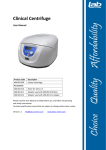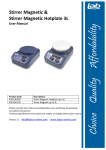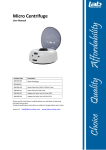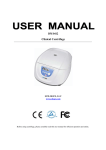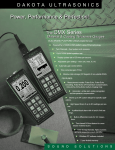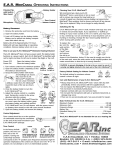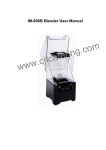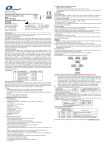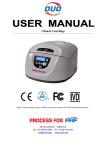Download User Manual
Transcript
Mini Centrifuge User Manual Product Code Description 400.003.050 High Speed Mini Centrifuge Accessories 400.003.055 Rotor for High Speed Mini Aluminium 400.003.056 Rotor for High Speed Mini Plastic 400.003.065 Adapter for Rotor 2ml to 0.2ml PK 24 400.003.066 Adapter for Rotor 2ml to 0.5ml PK 24 Please read the User Manual carefully before use, and follow all operating and safety instructions! Technical specifications and outline are subject to change without prior notice. Version 1.1 [email protected] www.labco-online.com 1 Contents Introduction 3 Warranty 3 Delivery 3 Safety reminder 4 1. Specifications 7 2. Declaration of Conformity 7 3. Required operational conditions 8 4. Installation 8 5. Structure 9 6. Operation panel 10 7. Rotor preparation 12 8. Operation 13 9. Maintenance 17 10. Troubleshooting 18 11. Instructions of rotor and tube 20 12. Calculate RCF 23 After-sales service 23 2 Introduction Welcome to the Mini Centrifuge User Manual; Users should read this Manual carefully, follow the instructions and procedures, and beware of all the cautions when using this instrument. Warranty Warranty of the Centrifuge This centrifuge is guaranteed for 12 months from the date of delivery provided that it has been operated and maintained properly. Warranty of the rotor Please pay attention, do not use the rotor once it has been corrosion or fatigue damage. We do not guarantee this centrifuge and the rotor under the following conditions even if within the guarantee period expires: (1) Failures caused by incorrect installation. (2) Failures caused by rough or improper handling. (3) Failures caused by conveyance or relocation after installation. (4) Failures caused by unauthorized disassembly or modification. (5) Failures caused by using parts of the other companies, such as rotors and adapters. (6) Failures caused by natural disasters including fire, earthquakes and so on. (7) Consumables and parts have a limited guarantee period Delivery This unit is supplied with one centrifuge unit, rotor and user manual. 3 Safety Reminder Common safety precautions Carefully read the following safety precautions for a thorough understanding. Follow the instructions and procedures described in this manual to operate this centrifuge safely. Carefully read all safety messages in this manual and the safety instructions on the instrument. Safety messages are labelled as indicated below. They are in combination with signal words of “WARNING” and “CAUTION” with the safety alert symbol to call your attention to items or operations that could be dangerous to you or other persons using this instrument. The definitions of signal words are as follows: WARNING:Personal Danger Warning notes indicate any condition or practice, which if not strictly observed, could result in personal injury or possible death. CAUTION:Possible damage to instrument; Caution notes indicate any condition or practice, which if not strictly observed or remedied, could result in damage or destruction of the instrument. NOTE:Notes indicate an area or subject of special merit, emphasising either the product’s capability or common errors in operation or maintenance. Do not operate this centrifuge in any manner not described in this User manual. When in doubt or have any troubles with this centrifuge, ASK FOR HELP. 4 The precautions described in this User manual are carefully developed in an attempt to cover all the possible risks. However, it is also important that you are alert for unexpected incidents. Be carefully operating this centrifuge. WARNING: This centrifuge is not explosion-proof. Never use explosive or flammable samples. Do not install the centrifuge in or near places where inflammable gases are generated or chemicals are stored. Do not place dangerous material within 30cm around the centrifuge. Make sure to prepare necessary safety measures before using samples that are toxic, radioactive or contaminated with pathogenic micro-organisms at your own responsibility. If the instrument, rotor and/or accessories that has been contaminated by solutions with toxic, radioactive or pathogenic materials, clean it according to the decontamination procedure that you are specified. If you require services at site, please sterilise and decontaminate it in advance, and then notice the service centre involved in the details of the particular materials. Do not handle the power cord or turn on or off the POWER switch with wet hands to void electrical shocks. For safety purposes, do not enter within 30cm around this centrifuge while it is in operation. While the rotor is rotating, never forcedly release the door lock. Unauthorized repairs, disassembly, and other services to the centrifuge except by our service centre are strictly prohibited. 5 CAUTION This centrifuge must be located on one firm and level table. Make sure the centrifuge is horizontal before running. Make sure the angle between the door and cover is greater than 70 degrees when open the door. Be careful not to put your fingers or hands between the door and cover when the door is off. Do not move or relocate this centrifuge while it is running. When there is fluid in the rotor chamber, please promptly dry with a dry cloth to avoid sample contamination. Ensure to remove any objects and fragments of the tubes dropped inside the rotor chamber before running this centrifuge. Caution on rotors 1. Always check for corrosion and damages on the rotor surface before using it. Do not use the rotor if such abnormality found. 2. Do not set the centrifuge speed override the allowable minimum speed of the rotor kits (rotor or the other adapters). Make sure to run it below the allowable minimum speed. 3. Do not exceed the allowable imbalance. 4. Use the rotor and tubes within their actual capacities. 5. If the rotor is provided with a lid, ensure it is tightened before the operation. If any abnormal condition occurs during operation, please stop it immediately and contact our service centre. Notice the service the alarm code if displayed. 6 1. Specifications Maximum speed 15000rpm, increment: 100rpm Maximum RCF 15100×g, increment: 100×g Maximum capacity 2ml×12 Timer 30 seconds -99 minutes-HOLD, continuous operation Driving Motor Brushless DC motor Safety devices Door interlock, over-speed detector, over-temperature detector, automatic internal diagnosis Power requirements Single-phase, 110V-240V, 50Hz/60Hz, 3A Dimensions(mm) (L)255×(W)245×(H)140 Weight 6kgs Additional features Speed/RCF switch, Pulse operation, Processing display, Voice reminder 2. Declaration of Conformity Construction in accordance with the following safety standards: EN 61010-1 EN 61010-2-10 Construction in accordance with the following EMC standards: EN 61326-1/ FCC Part 15 Subpart B/ IECS 001 Associated EU guidelines: EMC-guidelines: 2004/108/EC Instrument guidelines: 2006/95/EC This ISM device complies with Canadian ICES-001. 7 3. Required Operational Condition Basic Operational Conditions 1. Power: 110V-240V, 50Hz/60Hz, 3A. 2. 3. 4. 5. Ambient temperature: 2℃-40℃. Relative humidity: ≤80%. No vibration and airflow around. No electric dust, explosive and corrosive gases around. Transport and Storage Condition 1. 2. 4. Storage temperature: -40℃-55℃. Relative humidity: ≤93%. Installation This section describes the instructions that you should abide by when installing the centrifuge to ensure your safety and the optimum performance. Before moving the centrifuge, the rotor must be removed. WARNING: Incorrect power supply may damage centrifuge. Make sure the power source conforms to the required power supply before connecting. Location 1. 2. 3. 4. Locate this centrifuge on a firm, flat and level table; ensure the four feet of this centrifuge stand on the table firmly. Avoid installing on a slippery table-board that conveys vibration. Ideal ambient temperature is 20℃±5℃, avoid placing the centrifuge in direct sunlight if temperature exceeds 30℃. Keep clearances of at least 10cm on both sides of centrifuge and at least 30cm behind it to ensure its cooling efficiency. No heat or water resource nearby, otherwise easily cause sample temperature increase or centrifuge failures. 8 Connection of the power cord and grounding WARNING: Do not touch the power cord with wet hands to avoid electrical shocks. This centrifuge must be grounded properly. 1. 2. 5. This centrifuge is equipped with a 3P flat plug; grounding can be done just by plugging the 3P plug into the outlet. A cover 10A outlet which has a good ground is required, and meets with local safety requirements. Structure Door lock hook Rotor LCD Display Door release hole Foot Operation panel Figure 5.1 400.003.050 front view of centrifuge 9 View Door Power inlet Power switch Air vents Figure 5.2 D2012 Rear view of centrifuge 6. Operation Panel Speed area Lock status 150 x 100rpm (1) (2) Time area 12 min (3) (4) (5) Figure 6-1 Operation Panel 10 Item Symbol Name Function Select button 1 Press the button to choose the parameter which you want to modify. When the door closed, press and hold the button to accelerate running, release the button to stop it. 2 Pulse button 3 Parameter button 4 Open/ lock button 5 Start/ Stop button Speed area Lock status Clockwise rotate to increase parameter values. Counter-clockwise rotate to decrease parameter values. Press down the button, shift between speed and RCF display. Press the button to open the door The button is not available when the centrifuge is running. Press down the button to start running. The centrifuge will stop running if the button is pressed during centrifugation. Time area 150 x 100rpm 12 min Figure 6-2 the main interface The main interface as figure 6-2. At this point speed was set to be 15000rpm, the running time was 12 minutes. When speed symbol display symbol into 10 scales. is rotating, indicating the centrifuge is running. Time display the rate of working to time setting. The total time setting is divided 11 7. Rotor Preparation Prepare the sample Inject the sample into tubes. CAUTION: Excessive sample may cause leakage in the centrifuge tube, keep the actual capacity. Do not exceed the actual capacity specified in the instruction manual. Keep the tubes balanced Although this centrifuge can accept sample balancing by eye, we recommend that you use this centrifuge in a well-balanced condition to prolong its life expectancy. o Never intentionally run the centrifuge under unbalanced condition even though the allowable imbalance is not exceeded. Inspect the rotor CAUTION: Any abnormalities such as corrosion or scratches are found, stop using the rotor and contact our service centre. Only manufacturer’s rotors should be used with this unit. Symmetrically load centrifuge tubes in rotor CAUTION: Make sure the rotor door is securely fixed on the rotor & rotor and spindle are tightened. Otherwise, the rotor may be moved off while rotating and cause damage of the centrifuge or rotor. 12 8. Operation CAUTION: Do not push or lean against the centrifuge while it is running. Do not run the centrifuge with fragments of tubes or dew drops left in the rotor chamber. If this centrifuge makes strange noise during its operation, stop it immediately and contact our service centre. Notify the alarm code if displayed. Normal Operation Turn on the POWER switch and the centrifuge will display the running interface last time after passing the self-checking process. (See figure 8-1) Speed area Lock status 150 x 100rpm Time area 12 min Figure 8-1 the last running interface o Speed: 15000rpm. Running time: 12 minutes. o The door lock is released. Rotor loading and removal CAUTION: Load the rotor on the spindle to ensure rotor is in position until it contacts with the spindle, and tighten the screw to connect firmly the rotor with spindle, otherwise the rotor maybe move off to damage the centrifuge. Should be confirmed the door is firmly tightened with rotor. 13 Locking Nut Rotor Lid Figure 8.2 the rotor installation Fastener Load the rotor on the spindle to ensure rotor is in position until it fits well with the spindle. Rotate the rotor slightly by your fingers to double check, if the rotor vibrates obviously, load the rotor again. Hold on the rotor with one hand, tighten the nut clockwise with the other hand, and make sure it’s tightened firmly. Put the rotor lid on the rotor, press the fastener down and make the fastener join with the rotor nut tightly. Close the door and start running. To release the rotor, first pull the fastener up to remove the lid and then turn the rotor nut counter-clockwise. 8.1.2 Press the Set the operation parameters button to select required parameters. The parameter can be modified when the parameter is flashing. Clockwise rotate the parameter button value; counter-clockwise rotate the parameter button to increase parameter to decrease parameter value. The minimum speed increment is 100 rpm, the minimum time increment is 1 second. 14 (1) Set the speed Press the select button , choose the speed unit rpm, showing the speed parameter. While select speed button, the speed symbol will flash into the speed parameter input status. The minimum speed value you can set 500rpm, the minimum increment is 100rpm. Clockwise rotate parameter button clockwise rotate parameter button to increase parameter value; counterto decrease parameter value. You can quick set value by parameter button There is a circulating function to increase/decrease parameters. Clockwise rotate , quickly rotate parameter button to speed up parameter changing. parameter button , values circulate from small → large → maximum → minimum; counter-clockwise rotate parameter button , values circulate from large → small → minimum → maximum. (2) Set the time Press select button Rotate parameter button , time value flash into time setting mode. to set running time range from 30 seconds to 99 minutes. When time displays as HD, that showing long-running mode. 8.1.3 Start the operation (1) Press running button to start running It will start timing once the rotor starts running; the screen displays remaining run time. (2) Inquiry and modify the operation parameters 15 Press select button , return to the preparation interface and displays setting parameters. Press again the select button flashing, rotate parameter button , once the parameter symbol is to modify parameters. Release button after 5 seconds, centrifuge will return to normal operation mode and run process according to the new parameters. After the time parameter has been modified, the operation time is not cleared and will continue to be accumulated. (3) Alarm display If anything is wrong in processing, the centrifuge will brake to stop automatically, and display the error code on the time area. You can find out the malfunction causes by checking the table 10-1, and make correct actions accordingly. 8.1.3 End the operation (1) The centrifuge will break when it reaches the setting time or button is pressed. When the rotor stops rotating, centrifuge will start beeping to alarm the operation was over. (2) Open the door The door can be released automatically when the operation was over. After door closed, you are able to press the After ending the operation, the program will store the setting parameters of this button to open it. operation, and will recall these parameters when restart the program. (3) Open the door and take out the rotor and sample. 8.2 RFC Operation Turn on the POWER switch. Set a RCF value. Press the select button parameter input status. , choose speed unit ×g, the speed symbol will flash into RCF 16 If no button is pressed after the speed parameter has flashed for 5 seconds, the inputting mode will be shut down. (1) Rotate parameter button to input a RCF value, RCF increment is100×g. (2) Set operating conditions The other operation, please refer to the section 8.1. 8.3 Pulse Operation This function is used to remove the residual samples adhered on the interior of the tubes. Note:The button works only when the rotor stopped and the door locked. (1) Turn on the POWER switch and load the rotor on the spindle, tighten the rotor door and make sure it is in secured position, and then close the door. (2) The centrifuge gets into preparation mode and displays last running parameters. (3) Press knob and hold, speed up to reach the maximum speed. While release knob during acceleration, the centrifuge will start to decelerate and stop. 9. Maintenance Not following the recommended instructions for cleaning or disinfecting may damage the centrifuge. (1) Centrifuge If the centrifuge is exposed to ultraviolet rays for a long time, the color of the doors may change and/or the label may come off. After using, cover the centrifuge with a piece of cloth to protect it from direct exposure. Once the centrifuge is heavily dirty, clean it with a cloth or sponge moistened with a neutral detergent solution. Sterilise the centrifuge by wiping with a cloth moistened with 70% ethanol solution. (2) Rotor chamber CAUTION:Do not directly pour water, neutral detergent or disinfectant solution into the rotor chamber. Otherwise fluids may leak into the drive units and cause corrosion or deterioration to the bearings. 17 Once the rotor chamber is dirty, clean with cloth or sponge moistened with a neutral detergent solution. Sterilise the centrifuge by wiping with a cloth moistened with 70% ethanol solution. (3) Drive shaft It’s recommended having regular maintenance for the drive shaft. You can wipe the drive shaft with soft cloth, and then apply a thin coat of silicon grease to it. (4) Door Clean and sterilise the door using the same method as the step 1). (5) Rotor To prevent corrosion, remove the rotor from rotor chamber. If do not use regularly then detach the rotor door and flip the rotor to dry the tube holes. If a sample is leaked in the rotor, rinse the rotor with water. Apply a thin coat of silicon grease to the rotor when it is completely dried. The rotor should have regular maintenance, its recommended cleaning it each 3 months to ensure tube and rotor holes keep clean, and then apply a thin coat of silicon grease. 10. Troubleshooting Frequent problems list This centrifuge is designed with self-diagnosing function. When something is wrong and it is not available to operate, the alarm code will be displayed on the screen, and the operator can know the malfunction caused by the alarm code. WARNING: Do not open the door when the rotor is rotating during maintenance. 18 Symptom Nothing appears on the screen when the POWER is turned on. Abnormal vibration Alarm code appeared on the time display screen E-02 Door fault Causes ·Building power circuit breaker trips. ·the fuse was blown out. ·Rotor do not match with spindle ·Samples are imbalance ·Rotor lid loose ·The door opened in running. ·The button is pressed while the door opening. Solutions -Replace the fuse. ·Install the rotor again ·Weighting scales, install symmetrically ·Tighten the rotor lid firmly ·Close the door immediately. ·Close the door,and then start to operate. E-06 Set wrong speed ·The setting speed exceeds the allowable range. ·Modify the speed value. E-10~86 ·Read the service manual ·Contact with service centre Table 10-1 frequent problems and solutions Alarm code E-1~9 are related to wrong operating. You can continue running the centrifuge after the cause removed. How to open the door WARNING: Never open the door while the centrifuge is running. The door is opened once rotor is still rotating, close the door immediately. In the case of power on CAUTION:The door can be opened while the power is on and the rotor stops rotating Turn on the POWER switch, the door lock will release automatically. The door lock will release automatically once the operation finished. While the rotor stops, press button, door lock can be released to open the door. 19 In the case of a power outage If the door cannot be opened due to the power outage, open the door as the follows. (1) Make sure if the rotor is rotating. (2) Listen carefully to ensure that no rotating sound can be heard. Insert a door key into the hole to open the door lock. Identify the hole which is located on the top right side of the unit. Insert a door key into the hole and push forward to release the door lock, and then open the door. 11. Instructions of rotor and tube CAUTION: Read the instructions thoroughly, correct use rotor. Do not exceed the allowable maximum speed of rotor, tube and adapters etc., be care that the allowable maximum speed of some adapters are lower than the rotor’s. The rotor instructions Rotor structure Locking nut Fastener Rotor block Spindle hole 11.1.2 Available rotors and adaptors Figure11-1 the rotor profile Lid Tube 20 Rotor type ID code 400.003.055 The rotor can be used as follows: 01 Tube 1.5/2.0ml tube 0.2ml PCR tube 0.5ml microtube Allowable imbalance(*) Volume Imbalance imbalance Max Speed (rpm) 15000 Max RCF (×g) 15100 8.5 18620 400.003.065 15000 15100 6.9 15110 400.003.066 15000 15100 7.6 16638 Adapter Table 11.1 Rotors and adapters Notice The centrifuge rotor can separate sample which density lower than 2.0g/ml. if the separated samples density is over 2.0g/ml, please calculate allowable speed depending on the following formula. 1/2 Allow Speed (rpm)= Maximum speed×(2.0(g/ml)/Sample density (g/ml)) Autoclaving The rotor is made of high-strength aluminium alloy material, can be high-pressure 2 sterilization: 121℃(1.0kg/cm )20 minutes. CAUTION: The lid of the rotor is made of plastics, cannot be high-pressure sterilisation, only11.2 ordinary Tubessterilisation can be used. 21 Cleaning and sterilising tubes please refer to the table below. Condition Cleaning Cleaning fluids Ultrasonic cleaning O:Applicable X:Inapplicable Material PA PC PP X X X Acidic(pH5 or lower) O O O Acidic(higher than pH5 ) O X O Alkaline(higher than pH9 ) O O O Alkaline(pH9 or lower) O O O Neutral(pH7) Warm water(up to 70℃) O O O O O O Neutral detergent(pH7) Sterilization 2 Autoclaving Boiling Ultraviolet sterilization Gas sterilization 115℃(0.7kg/cm )30minutes 2 121℃(1.0kg/cm )20 minutes 2 126℃(1.4kg/cm )15 minutes 15 to 30 minutes 200-300nm O X X O X O O X O X O O X O X Ethylene oxide O X O Formaldehyde O O O PA: Polyallomer; PC: Polycarbonate; PP: Polypropylene Table 11.2 Cleaning and sterilizing conditions for tubes 11.2.2 Cleaning PC tubes PC materials are low in chemical resistance against alkaline solutions. Avoid using neutral detergents with pH higher than 9. Note that pH of some neutral detergents are still higher than 9 even if diluted according to the instruction in the manufacturers catalogue. Use detergent with its pH between 7 and 9. 11.2.3 Autoclaving PA, PC and PP tubes PA begins softening at about 120℃, PC and PP at about 130℃. Autoclave PA tubes at 115℃( 2 2 0.7kg/cm )for 30 minutes and PC and PP tubes at 121℃(0.1kg/cm )for 20 minutes. If a certain temperature is exceeded, the tubes may be deformed. When using a sterilising chamber, please operate as follows: (1) Place tubes in vertical position. If tubes are placed sideways, they may deform into an oval shape due to gravity. (2) Remove screw nuts and inner covers to prevent from deformation or rupture. 22 (3) Wait until the sterilising chamber cools down to the room temperature before the tubes are removed. 11.2.4 Condition and life expectancy of tubes The life expectancy of plastic tubes depends on the characteristics of samples, speed of the rotor used, and temperature applied, and so on. When the plastic tubes are used for centrifuge of ordinary aqueous samples (pH between 5 and 9), their life expectancies are defined as follows. Be operated at the maximum speed: High quality tubes (PA, PC, PP): 30-50 operations Ordinary tubes (PA, PC, PP): around 10 operations (Using in low speed can extend the tube life). Life expectancy of tubes also depends on the pre-treatment conditions such as cleaning and sterilisation, lifetime can be cut down. Notice: Do not use cracked tubes. 12. Calculation relative Centrifuge Force (RCF) An RCF can be determined as the calculation formula following. 2 -5 Calculation formula: RCF=1.118×r×n ×10 r—rotating radius, unit: cm; n—rotating speed, unit: rpm After sales service In order to ensure to operate centrifuge safely and efficiently, it is necessary for regular maintenance. If centrifuge has problems, do not attempt to repair it by yourself. Contact our sales or service centre. 23 24

























